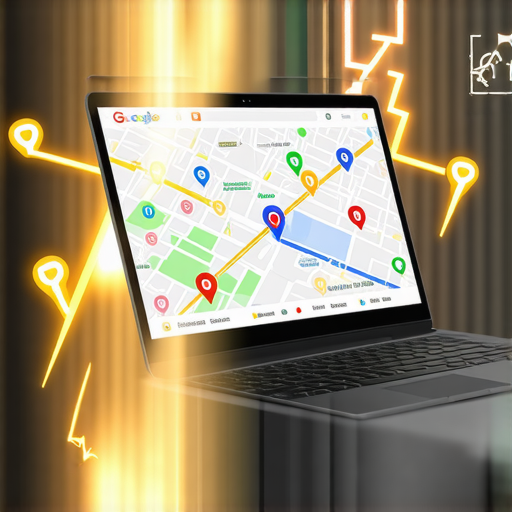My Personal Journey into Google Maps Optimization with SEO Automation
Not long ago, I found myself frustrated trying to improve my local business’s visibility on Google Maps. Despite offering excellent services, my rankings remained stubbornly low. That’s when I stumbled upon the power of SEO automation tools designed specifically for local SEO and Google Maps. Implementing these strategies was a game-changer, and I want to share my experience to help others navigate this rapidly evolving landscape.
Why I Started Exploring Maps Software and SEO Automation
As a small business owner, I know firsthand how essential local visibility is. I read an article about SEO automation tips for 2024 and realized that manual efforts weren’t enough anymore. The landscape was shifting quickly, with new algorithms and ranking factors. I needed a smarter approach—hence, I turned to top-rated maps software and automation tools that promised rapid results.
How I Used Automation to Accelerate My Google Maps Rankings
At first, I was skeptical. But once I integrated cutting-edge maps software and automation tactics, I saw immediate improvements. I focused on automating NAP consistency, gathering reviews, and optimizing my Google My Business profile with minimal manual input. The beauty was in the efficiency—my rankings started climbing faster than I expected, often within weeks.
What Are the Key Strategies That Made a Difference?
From my experience, the most effective strategies involved leveraging proven SEO automation tactics like automated review requests, profile updates, and local keyword targeting. These tactics created a consistent signal for Google, boosting my local pack presence. I also used lightning-fast maps software to monitor my rankings and adjust strategies dynamically.
Is SEO Automation Suitable for All Types of Local Businesses?
In my honest opinion, yes. Whether you run a restaurant, a dentist office, or a retail store, automation can streamline your local SEO efforts. The key is choosing the right tools that fit your business needs. I recommend exploring options like those reviewed on top maps software for 2024. Remember, automation isn’t about replacing human effort but enhancing your capabilities efficiently.
If you’re serious about boosting your Google Maps rankings, I encourage you to share your experiences or ask questions below. Your journey might be just one automation tweak away from massive growth!
Unveiling Hidden Layers of Google Maps Optimization with Automation
As seasoned local SEO practitioners know, staying ahead in Google Maps rankings demands more than just basic optimizations. The real game-changer lies in harnessing sophisticated maps software integrated with powerful automation tactics. These tools can unlock levels of efficiency and precision that manual efforts simply cannot match.
How Can Automation Uncover New Opportunities for Local Businesses?
Automation empowers businesses to identify and leverage emerging ranking factors before competitors even notice. For instance, automated review generation not only boosts credibility but also signals to Google your active engagement. Meanwhile, dynamic profile updates ensure your listings remain fresh and relevant, adapting swiftly to algorithm shifts.
Advanced tools now allow for real-time ranking monitoring and rapid response, enabling businesses to tweak their strategies dynamically, maintaining a competitive edge.
What Are the Nuanced Challenges That Experts Must Navigate?
While automation offers immense benefits, it also introduces complexities that require expert handling. Ensuring compliance with Google’s guidelines is paramount; over-automation or unnatural link-building can lead to penalties, undermining efforts. Moreover, integrating automation tools seamlessly with existing CRM and marketing systems demands technical expertise to prevent data silos or errors.
For example, automating review requests must be done carefully to avoid spammy behaviors, which Google actively penalizes. Similarly, maintaining NAP consistency across multiple directories requires meticulous setup and ongoing oversight, even when leveraging powerful automation solutions.
How Do Top-tier Automation Tools Elevate Your Local SEO Strategy?
Leading tools now incorporate AI-driven insights that refine keyword targeting and content suggestions, aligning your profile with evolving search intents. They also automate local keyword research and optimization, ensuring your business appears in the most relevant search results.
Furthermore, these solutions facilitate multi-location management, allowing businesses with multiple storefronts to optimize each listing individually, yet efficiently. This scalability is crucial for brands aiming to dominate their regional markets.
For deeper insights and tailored automation strategies, I recommend exploring advanced SEO automation tactics that are shaping the future of local search dominance.

Is Your Business Ready for the Next Level of Local SEO Automation?
If you’re contemplating whether to elevate your strategy, consider the scalability and precision automation offers. It’s not just about quick wins but building a resilient, future-proof local SEO foundation. By integrating the latest tools and techniques, your business can stay ahead of the curve, consistently outperforming competitors.
Would you like to share your experiences with local SEO automation, or need guidance on selecting the best tools? Drop your thoughts or questions below, and let’s dive into the evolving world of Google Maps optimization together!
Deepening the Personal Journey: Navigating the Nuances of SEO Automation
As I delved further into the complexities of local SEO, I realized that automation isn’t a one-size-fits-all solution. It demands a nuanced understanding of your niche, competitors, and the subtle signals Google uses to rank businesses. My experience taught me that while tools like top-tier automation solutions significantly streamline processes, they also require a strategic human touch to interpret and act on data insights effectively.
Are You Ready to Conquer the Advanced Layers of Map Optimization?
From my perspective, the real challenge lies in mastering these advanced layers—leveraging AI-driven keyword insights, dynamic profile management, and real-time ranking adjustments. For instance, integrating cutting-edge automation tactics with a deep understanding of local search behavior can propel your business ahead of competitors. But it’s not just about automation; it’s about how you interpret and customize these tools to fit your unique context.
How Can You Balance Automation with Authentic Engagement?
One of the most subtle yet impactful aspects I’ve discovered is maintaining authenticity amidst automation. Google’s algorithms are becoming increasingly sophisticated at detecting unnatural patterns. For example, automated review requests must be personalized enough to avoid seeming spammy. The key is to set up automation that encourages genuine customer interactions without crossing ethical boundaries. This balance ensures sustained rankings and builds trust with your audience.
Moreover, regular monitoring and human oversight remain indispensable. Even the most advanced systems require expert calibration—something I learned the hard way when over-automating led to penalties. The art is in knowing when to step back and review your automation workflows—this is where experience and intuition play a vital role.
Integrating Automation Within a Holistic Local SEO Strategy
Automation should complement, not replace, your overall strategy. For example, pairing automated local keyword research with manual content creation ensures your listings remain relevant and engaging. Also, automation can help you identify emerging trends faster, giving you the agility to adapt before others catch on.
From my experience, the most successful local SEO efforts are those that blend high-tech automation with personalized customer engagement. This combination fosters genuine relationships and signals to Google that your business is active, trustworthy, and relevant.
What’s Next in the Journey of Google Maps Optimization?
Looking ahead, I believe the future belongs to those who can harness AI and automation ethically and strategically. The landscape is shifting towards smarter, more intuitive systems that learn from your input and adapt in real time. Staying ahead requires continuous learning, experimentation, and a willingness to refine your approach based on data insights.
If you’re exploring automation, I encourage you to share your experiences or ask questions below. The journey is complex but incredibly rewarding when approached with curiosity and a genuine desire to grow. Remember, the key is to combine the power of automation with your unique human touch—this is what truly sets your local business apart in the crowded digital space.
Harnessing AI-Driven Insights for Next-Level Map Optimization
As I continued to explore the depths of Google Maps SEO, I discovered that leveraging AI-powered analytics tools can exponentially enhance your local search strategies. These advanced solutions analyze vast datasets, uncovering hidden ranking signals and emerging local trends that manual analysis might miss. Integrating such AI insights with proven automation tactics, like those detailed on top SEO automation tools, allows for a nuanced and dynamic approach to local optimization.
Strategic Use of Automation for Multi-Location Businesses
Managing multiple storefronts can be daunting without sophisticated automation. I found that utilizing centralized management platforms—capable of automating NAP consistency, review solicitation, and localized content updates—ensures each location maintains optimal visibility. Automated geo-targeted keyword optimization, combined with real-time ranking monitoring via lightning-fast maps software, allows for swift adjustments tailored to regional search behaviors. This scalability is essential for brands aiming to dominate regional markets and sustain competitive advantages.
Ensuring Ethical Automation: Balancing Efficiency with Google Guidelines
One of the most nuanced challenges I encountered was maintaining compliance with Google’s strict guidelines while automating aggressive optimization tactics. Over-automation, especially in review generation or link-building, can trigger penalties. To mitigate this, I adopted a strategy of personalized automation—crafting review requests and content updates that resonate authentically with customers. Regular manual oversight remains critical; tools like advanced SEO automation solutions offer invaluable data, but human judgment guides appropriate actions, preventing algorithmic penalties.
The Future of Local SEO: Integrating Machine Learning and Predictive Analytics
Looking ahead, the integration of machine learning models into local SEO workflows promises unprecedented precision. Predictive analytics can forecast ranking fluctuations based on seasonal trends, competitor movements, or industry shifts. By proactively adjusting strategies—such as pre-emptive review campaigns or profile updates—businesses can stay several steps ahead. I recommend exploring advanced automation tactics that incorporate these emerging technologies to future-proof your local search presence.
How Can Experts Use Data-Driven Decision Making to Surpass Competitors?
In my experience, data-driven decision making is the cornerstone of high-level local SEO mastery. By harnessing detailed analytics—such as keyword performance, review sentiment analysis, and competitor benchmarking—you can craft hyper-targeted strategies. Automated tools that synthesize these insights provide actionable recommendations, enabling rapid iteration and continuous improvement. For instance, automating competitor analysis via SEO automation tools reveals gaps in their profiles, presenting opportunities for your business to establish dominance.
If you’re eager to elevate your local SEO game, I encourage you to share your experiences or ask specific questions about implementing these advanced strategies. Together, we can unlock the full potential of automation and data intelligence to propel your business forward.
Things I Wish I Knew Earlier (or You Might Find Surprising)
Automation Is Not a Magic Bullet
Initially, I thought deploying automation tools would instantly skyrocket my Google Maps rankings. However, I quickly realized that automation is most effective when paired with strategic human oversight. It’s tempting to set and forget, but the real magic happens when you interpret data and adjust tactics accordingly.
Quality Over Quantity Still Matters
While automation can massively streamline review requests and profile updates, I found that genuine customer engagement still trumps automated interactions. Authentic reviews and meaningful responses build trust and signal to Google that your business is active and reputable.
Over-Automating Can Backfire
One lesson I learned the hard way is that overly aggressive automation—like spammy review requests or unnatural link-building—can lead to penalties. Balance is key: automate wisely, and always keep Google’s guidelines in mind.
Local SEO Is a Continuous Journey
SEO automation isn’t a one-and-done effort. It’s a continuous process of monitoring, tweaking, and optimizing. The landscape evolves, and so should your strategies, leveraging automation as a helpful tool rather than a shortcut.
Resources I’ve Come to Trust Over Time
- Google’s Official My Business Guidelines: The foundation for ethical automation; understanding Google’s rules is crucial for sustainable success.
- Moz’s Local SEO Resources: Offers in-depth insights into local search rankings and optimization strategies that complement automation efforts.
- Search Engine Journal: Regularly features the latest trends and case studies on automation and local SEO, helping me stay updated.
- Neil Patel’s Blog: Practical tips on SEO automation, especially about balancing automation with authentic engagement—highly recommended for beginners and pros alike.
Parting Thoughts from My Perspective
My journey into Google Maps SEO automation taught me that success relies on a blend of smart tools and human intuition. Automation can accelerate progress, but understanding the nuances of local search and maintaining authenticity are what truly set your business apart. If you’re considering diving into automation, do so thoughtfully—use the tools to enhance your efforts, not replace them. I’d love to hear your experiences or answer any questions you might have. Feel free to share your story or ask below—let’s grow together in this ever-changing landscape of local SEO!
,

